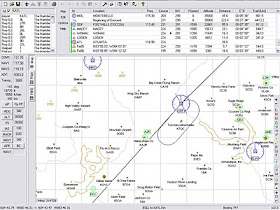

So, the next time you think about not using the default flight planner, I recommend you re-evaluate your initial stance and take advantage of just how powerful and easy to use it is for those willing to take the time and use it as it was intended. Virtual pilots can edit (how appropriate!) the route to be more realistic (follow real world charts) AND by doing so, they can make their routes align the plane for a perfect ILS hand-flown approach, or Category III autoland. The window that displays the route once it is plotted.
#FSNAVIGATOR FSX HOW TO#
However, this is also where the power and flexibility of the default planner comes into play for users who know how to use it properly: This becomes a major problem when it comes time to land because what it neglects to do is line you up with the destination airport's ILS Feather (the green arrows on the flight planner map) and localizer for approach. This should come as no surprise because FSX is designed primarily for casual virtual pilots who fly the default planes that do not simulate realistic navigational systems.Ī bigger limitation of the above is a lot of times the generated routes merely consist of marking the departure (origin) airport, destination airport, and maybe a single way point in between as a reference marker. In the rare cases it does, the routes are very general and only include one way point (out of maybe three, or four) from the entire SID, or STAR. The primary limitation is the FSX flight planner doesn't follow any SID, STAR or real air route charts. Here is where the default flight planners value ends and its limitations begin, unfortunately: The worst of these bugs was mentioned in a previous entry ("The Theory of Managed Flight") and this particular bug makes commercial flight useless when it comes time to land (vector for final approach). It has severe shortcomings, bugs that have never been fixed and isn't all that realistic to begin with. However, I strongly recommend FSX pilots not use ATC at all. ATC can only interact with flight plans generated by FSX. **For realistic aircraft equipped with FMCs, you must IMPORT the FSX generated flight plan into your FMC in order for ATC to follow along and vice versa. You can also interact with the simulated ATC and it will guide you along your route like real ATC would (initial altitudes and climb speeds, transition to higher cruise altitudes, traffic reports, and way point reporting points).** This is good for the default aircraft that do not simulate complex navigational systems like FMGCs and vertical profiles, and these generated routes can be followed using the default GPS autopilot found in all the default FSX airplanes. If you are new to the default flight planner, or have always used more featured programs to plan your routes here is a brief overview of how it operates and what it has to offer:ġ) You select your city pair (departure and arrival airports).ģ) You then have a choice between VOR to VOR, high altitude airways, low altitude airways, or a direct route.Ĥ) You hit "Find Route" and it generates a route. Granted, it isn't as complex as stand alone programs like FSCommander, or FSNavigator, but its strengths lie within its simplicity and ease of use. FSDS 3.In this entry I am going to discuss the default Flight Planner that is often overlooked in FSX due to it being considered "too basic" and not full-featured enough. The model should run in Acceleration and in FS2004 but it is not tested and not completely configured for FS2004. The effects allows you to fire broadsides to starboard and port separately. Twenty four cameras let you explore the whole ship: The deck, the lower gun deck and you can enjoy the sailors views from high above in the masts. The Sim-model is almost complete rigged with hundreds of ropes and has fourteen animated guns, six animated stun sails and six unanimated crewmen.

Renamed 'Surprise', she served successfully until 1802.

The history of the real ship began 1794 as French sloop Unite, captured by the Brits two years later. Surprise is now at the Maritime Museum of San Diego.
#FSNAVIGATOR FSX MOVIE#
For the movie "Master and commander", regarding Patrick O'Brian's famous novel, the boat was restorated to a historical replic of a british frigate of the 18th century. This sailing ship is based on the former replic HMS Rose, built in 1970. FSX Frigate HMS Surprise from the 18th century.


 0 kommentar(er)
0 kommentar(er)
